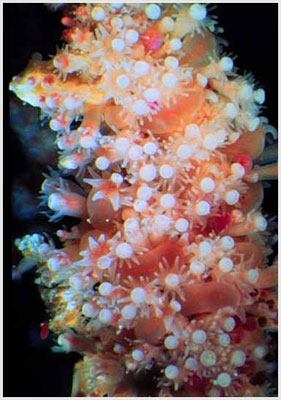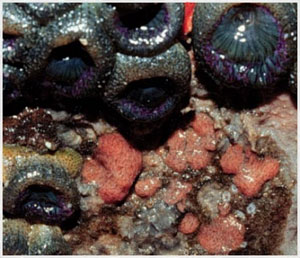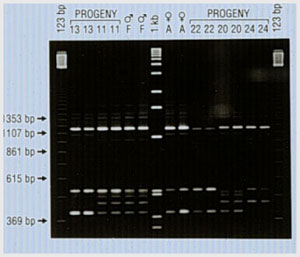 Female Hydractinia milleri |
 Hydractinia milleri colonies in the intertidal |
|
 Paternity analysis using RAPD PCR markers |
||
The recent advent of convenient molecular techniques for assays of genetic identity, parentage, and population structure has made studies of clonal population dynamics and life history tactics more tractable. In collaboration with Rick Grosberg (U.C. Davis) I have been using Random Amplified Polymorphic DNA (RAPD) markers to construct molecular fingerprints of colonial hydrozoans. These highly polymorphic markers allow for an investigation of population structure and mating success in species that vary in dispersal potential and the degree of inbreeding. Correlating population substructure with morphology, behavior, and resource allocation will provide insight into both the mechanisms responsible for patterns of population substructure and how the degree of relatedness can influence the evolution of life-history characteristics.
Relevant Publications:
2011 Levitan, D. R., N. D. Fogarty, J. Jara, K. E. Lotterhos, and N. Knowlton. Genetic, spatial, and temporal components of precise spawning synchrony in reef building corals of the Montastraea annularis species complex. Evolution 65:1254-1270 [PDF].
1997 Grosberg, R.K., M.W. Hart and D.R. Levitan. Is allorecognition specificity in Hydractinia symbiologicarpus controlled by a single gene? Genetics 145:857-860 [PDF]
1996 Grosberg, R.K., Levitan, D.R. and B.B. Cameron. Evolutionary Genetics of allorecognition in the colonial hydroid Hyractinia symbiologicarpus. Evolution 50:2221-2240 [PDF]
1996 Grosberg, R.K., Levitan, D.R. and B.B. Cameron. Characterization of genetic structure and genealogies using RAPD-PCR markers: a random primer for the novice and nervous. Pages 67-100 in (J. Ferraris and S. Palumbi eds.) Molecular Zoology: Advances, Strategies & Protocols. Wiley Press.
1993 Levitan, D.R. and R.K. Grosberg. The analysis of paternity and maternity in the marine hydrozoan Hydractinia symbiolongicarpus using randomly amplified polymorphic (RAPD) markers. Molecular Ecology 2:315-326.